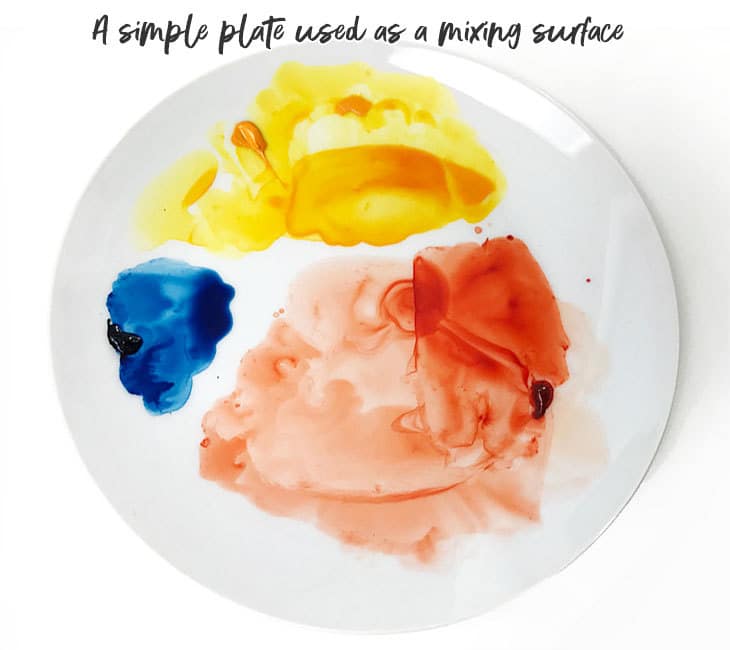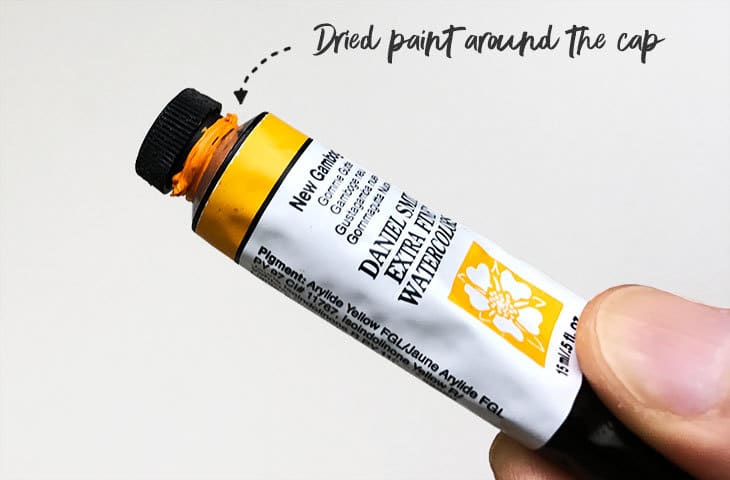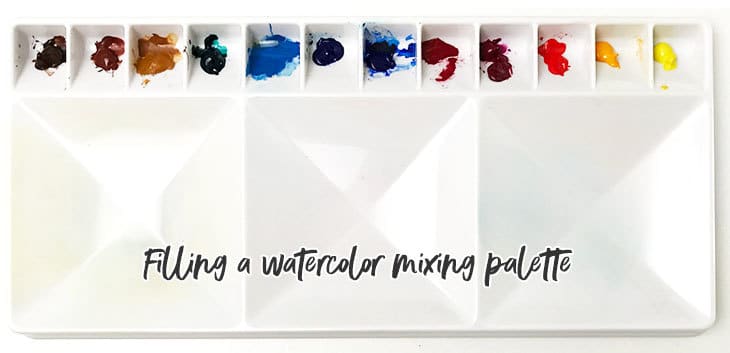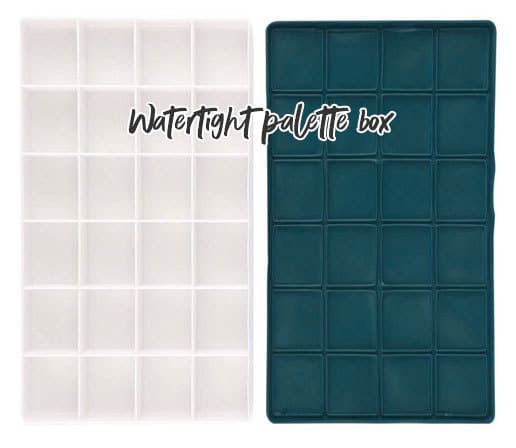How To Use Watercolor Paint In Tubes
It's a uncomplicated question… Right ?
And the respond probably seems obvious to more experienced watercolor artists.
I remember when I was learning about watercolor painting, I wasn't certain how other artists used tubes of paint. I found it quite mysterious how to handle paint in this class. And the more I idea about it the more puzzled I became.
I wanted to know the best way to apply watercolor paint from tubes.
With a footling experience, enquiry, and testing I became more than comfortable using paint from tubes, and today I still buy all my paint in this format ! I recollect this is the best way to use your watercolors.
The bottom line ?
Using tubes is a question of personal choice. It takes some time, trial and error to find the technique which works best with your workflow.
But in general in that location are a few basic methods :
-
ane
You can use fresh pigment direct from the tube by squeezing out some paint onto a mixing surface, then mix with h2o. -
2
Alternatively you squeeze out some paint into a mixing palette and allow it dry betwixt painting sessions. -
three
Or yous can make your own watercolor pans and ready a personalized watercolor palette.
Note: Every bit you've probably institute out, watercolor paint tin exist bought in different formats. The nigh mutual are tubes and pans . Pans are the small 'cakes' of dried pigment that can be purchased individually or in box sets of colour palettes.
Each private artist has his own habits, but from what I could notice from other artists workflow and my own personal experience these are the 3 most widespread ways of using tubes.
Want to know which method is best for you ?
Beneath I'll go into more detail about these three methods, plus a few tips and tricks to assist you lot use watercolors in this class.
Here's what I've learned most using watercolor from tubes:
i. Using fresh watercolor from the tube
Some people ever utilize fresh moist pigment directly from the tube. This is a very piece of cake and fast way to mix colors because the paint is already moist. In this format it is as well easier to mix a large corporeality of paint if you're painting on a big surface.
Colour from tubes is fully pigmented and saturated. Your paint doesn't become brighter. So it'southward easy to get a strong concentration of paint.
Using fresh pigment from the tube every time you paint has the reward of starting with clean fresh colors each fourth dimension. Some artists like to have fresh pure colors when they beginning a new painting. They don't want their colors to be stained with other pigments, and so this method of working suits them well.
Starting afresh in this way also means that your mixing surface is make clean and gratis from dust, and then you don't get strange bodies floating effectually in your watercolor washes!
Here'due south how this technique tends to piece of work:
How to mix watercolor paint from tubes

A few tips:
When yous showtime a new painting, begin with only a few colors. Quite ofttimes every bit you progress with a subject area, you lot might change ideas and decide to use a dissimilar colour design. My communication is to clasp out only the colors you demand to avoid wasting paint.
In the beginning yous may be tempted to dab a muddied brush into your pure paint dots. It takes a chip of subject to proceed you mixing habits make clean and avoid contaminating your pure pigments, but with experience your technique becomes more intuitive.
How to open watercolor tubes
"Just open the cap" I hear yous say !
This might seem obvious just sometimes opening new or one-time tubes of paint can cause problems.
With new tubes it's quite common to see a sudden gush of pigment when you lot take off the cap for the first time. Used tubes don't seem to encounter the same problem.
Just be careful when opening new tubes. Try not to put pressure on the tubes by squeezing them, and maybe open them over the well of your palette so you don't lose any contents.
When you open used tubes, sometimes yous can get flakes of stale paint fall out. Try to avoid the flakes falling on your clean paper or in your mixing palette.

Quondam tubes are another sticky trouble. Frequently if yous leave them for a while the paint dries and the cap becomes difficult to remove. The solution to this is to warm the cap in some way. Leaving paints "cap downwards" in some warm h2o usually helps.
If you lot run across this problem oftentimes, you might consider dipping the within of your cap in some glycerin or even honey before putting the cap back on. (Glycerin is used in paint formulas to help keep them soft).
2. Squeezing tubes into a mixing palette
With this approach yous let the paints dry out out in a mixing palette when not in use. You need to reactivate the paint with a small-scale amount of water each time you utilise them.
A mixing palette is unlike to a unproblematic mixing surface like a butcher tray or a ceramic dish. A mixing palette has two distinct parts:
Paint wells for squeezing out your pure paint.
A mixing area for mixing your pigment puddles.
In that location are a lot of dissimilar formats of mixing palettes and over time you'll find i which you prefer. (After a lot of testing I establish one of the all-time types is an Eldajon palette - you can find them at a skilful toll on Amazon ).

The advantage I have found with this method is that there is very niggling wasted paint. Reconstituting the dried paints with water is very like shooting fish in a barrel, and there is no loss of pigment saturation ( At to the lowest degree that's the case with the brand of paints that I use - meet my recommendations ).
Clean upwardly time is also reduced !
Here'southward how people tend to piece of work with palettes:
A few tips:
When mixing colors, bring out a bit more paint than you think yous need. In that location'due south nada equally frustrating as running out of a color mix and having to mix the exact same color twice.
Pigment will dry out in the palette when non in use. To reactivate the watercolors just add together some clean water to the wells before each new session. A lot of artists employ a spray bottle to pre-moisture their pigment.
If your paint wells practise become color contaminated or muddy, then just place the wells under a flow of warm running water. The surface layer of muddy color will dissolve leaving fresh pigment underneath.
1 of the problems with this method is the risk of dust or particle contagion between painting sessions. Depending on the type of palette used, I find it useful to cover the palette until my next painting. This can be as uncomplicated as an upturned dinner plate, or aluminium foil. Whatever you observe does the job well.
Depending on how long you get out your mixing palette between each new painting, it might exist advisable to put them in the fridge for storage, to prevent mold and evaporation.
I simply wanted to add a quick note nigh the term "palette" . In watercolor painting this term tends to refer to a few different things. This got me quite confused in the outset only there's an of import distinction.
First you lot have a mixing palette . This is the surface on which you mix your paint. There are loads of different types simply they usually take pigment wells for holding the pure paint, and a mixing area for blending paints together.
And then you lot have palette boxes or tins. Some of these are empty tins with wells for storing paint from tubes. Others are boxes containing pan paints, and tin can be empty or ready-filled.
Just to make things a chip more confusing, watercolor artists will oft talk nigh their "palette" when discussing their palette colors . This but refers to the range of colors they use.
Bewildered yet ? … Don't worry, you'll become used to it !
Watercolor palette with lid
Some artists prefer to go on their fresh tube paints continuously wet.
They use a "wet palette" option to go along them moist.
This method combines the advantages of working with fresh paint plus the power to create a personalized color palette. It eliminates the trouble of dissolving pigment at the beginning of each session, making mixing quick and like shooting fish in a barrel.
You can find special wet palette boxes with folding or snap on lids to accommodate your tube paints ( see the reviews for this leakproof palette on Amazon ). They accept the advantage of existence watertight and transportable.
They have a lid that prevents overnight evaporation and works as an effective dust cover.

The drawback is that wet paint tin go mouldy if left too long. Keeping them in the fridge volition help !
3. How to brand watercolor pans
Tubes of watercolor can be used to make your own watercolor pans.
You can of form buy paint already in pans (sometimes called cakes), but I prefer to fill empty pans with my favorite paint colors.
This is really easy to do (In fact information technology'southward a slice of cake… distressing, couldn't resist that !)
All you need is an empty palette box and some empty pans.
Pans come in two sizes: bigger total pans and pocket-sized half pans. Personally I prefer the full pans, just because it's easier to get the whole of my brush into the big pan when picking up paint.
Most palette boxes will fit both full and half pans.
I think this choice is dandy ! Firstly it let's me fix a personalized color palette, (set up-made box sets always include colors you lot don't want). Besides you can layout the colors the manner you want. This is good for your workflow considering you lot accept an established lodge fixed in your listen. I also remember information technology's more than price constructive than buying ready-made pans. I can fill up a pan and keep them topped up 3 or iv times with tube of paint. For me, the price difference between a pan and a tube makes the tube a more than economical selection. Storage is easy. When you're finished you only close the chapeau, which also keeps the pigment free from dust.
Here's how to make your own pans and setup a palette:
Using tubes to brand pans makes no difference to the quality of your watercolors. Manufacturers use the same formulas to brand the pans and their Tubes of paint. Tubes only have more liquid binders and fillers which evaporate when yous exit them to dry out.
How to recover stale watercolor paint tubes
Do y'all have some old watercolor tubes that have dried out over time ? Are they completely useless ?
There doesn't really seem to exist an expiry date for watercolors paints. I've heard of artists leaving tubes for several years and even so being able to use them!
Dried up pigment tubes can exist reconstituted past removing the paint from tube and adding gum standard arabic or even a little h2o.
Cut open up the tube, and then beat or chop the contents into small parts. Put the stale paint into a container with a little gum arabic and leave to rest a while. Stir the paint and add together more gum arabic until you recover a smooth mixture.
The whole process needs a lot of patience, but it tin can be done !
Using watercolor straight from the tube for spot color
Finally, for painting particular, or spot colors, I simply work direct from the tube. Unscrew the cap, wet the castor with simply enough h2o to lubricate the pure paint, then selection up some paint straight out of the tube.
This is usually when I'm using a color that I don't go on in my day to day palette, or for occasionally applying opaque colors such as Chinese White.
Comparison betwixt watercolor tubes and pans
1 of the advantages with tubes is you can start with a limited palette - buy a few tubes at a fourth dimension and add to your collection equally you evolve.
The pick between tubes or pans is more a thing of personal workflow. I find myself using both, but I always buy tubes first, and make my own pans as I need them.
Whether you purchase your paints in tubes or as pans will non affect the quality of your work. The paint is the same. Tubes are more pricey but in my experience they are more economical compared to buying ready filled pans.

Source: https://www.watercoloraffair.com/beginners-guide-how-to-use-watercolor-paint-tubes/
Posted by: moorefrehe1937.blogspot.com

0 Response to "How To Use Watercolor Paint In Tubes"
Post a Comment